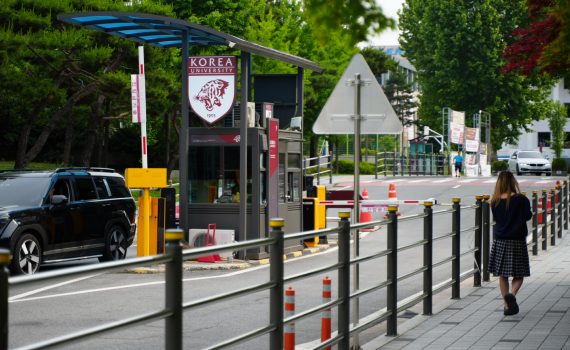Science & Technology

South Korea Presidential Election 2025: Students Embrace AI's Future Potential While Questioning Candidates' Preparedness for Tech Leadership
- 2025-06-03
- Politics
- By: Wang YunqiEdited by: BO Chuxuan
- 2025-06-03
Young voters in South Korea expressed different views on increasing funding for AI development, as some presidential candidates have mentioned AI in their speeches, amid the country's rising financial input for technology research and development. “I think it’s kind of a waste of money because we already have technologies like GPT, and China has DeepSeek. Developing AI requires a lot of information and money,” said Kim Jun Young, an English Education student at Korea University. “Still, we don’t really have sufficient resources to compete on the same level,” she added. Park (assume name), 26, majored in computer science, has also expressed doubts about the practicality and feasibility of AI policies proposed by different candidates. “ I’m doubtful whether they can achieve meaningful advancements in this field,” he said, adding that he thinks many candidates do not understand AI much. South Korea recently increased the research and development budget for 2025 by 16.1 percent year-on-year to a record high of KRW 24.8 trillion (HK$ 141.4 billion) with a focus on cutting-edge technologies such as artificial intelligence (AI), biotechnology, and quantum technology. The ambitious investment aims to position South Korea as a global leader in these fields. Lee Jae-myung, the presidential candidate of the Democratic Party, who leads the poll, has identified AI, renewable energy, and the cultural industries as essential tools for addressing South Korea’s economic challenges meanwhile Kim Moon-soo, first runner-up in the poll, from the conservative People Power Party, promote himself by creating a joint fund to boost AI development. Meanwhile, Lee Jun-seok, the youngest candidate among all, representing the Reform New Party, emphasises the importance of data freedom in AI development and highlights the role of Large Language Models (LLMs) in advancing the industry. AI has become a core driving force for national development, with applications spanning industries …

Digital Asset Week Hong Kong 2025 took place as Asia Pacific’s first tokenised retail fund prepares to be launched
- 2025-02-27
- Business
- By: Haoming Zhou、XIA FanEdited by: ZHAO Runtong、XIA Fan、BO Chuxuan
- 2025-02-27
Digital Asset Week Hong Kong 2025 kicked off with the Leadership Summit on Wednesday, bringing global traditional and digital asset insiders together, amid the launch of the Asia-Pacific’s first tokenised retail fund in the near future. “Digital Asset Week is the best event to connect to the people building the future of the digital asset ecosystem,” said Daniel Coheur, co-founder and chief commercial officer of Tokeny, an on-chain finance operating system developing company headquartered in Luxembourg. Known for inventing the ERC3643, one of the newest token standards for tokenisation of the Real World Asset in the blockchain, Tokeny plans to expand the number of employees in Hong Kong to capitalise on the opportunity. Confident about the industry's future, Thomas Zhu, Head of Digital Assets and Family Office Business of China AMC (HK), who will launch Asia Pacific’s first tokenised retail fund tomorrow, is confident about the future development of digital assets. Supported by Standard Chartered Bank, the tokenised retail fund will offer investors “opportunities to earn returns in Hong Kong dollars” through blockchain-based instruments. “We may be able to build another Chinese asset management company on the chain through blockchain technology,” he said. Hong Kong has recently taken action to boost digital assets, including preparing to issue the third tranche of digital bonds through the Hong Kong Monetary Authority, the city’s de facto central bank, and the hosting of Consensus 2025, the world’s top crypto and Web3 summit. Up to now, 10 virtual asset trading platforms have been operating in Hong Kong in the past five years, with the HKEX Bitcoin Reference Index surging more than 870%. As a response to its increasing development, the Hong Kong Securities and Futures Commission launched the “A-S-P-I-Re” for the regulatory roadmap for Hong Kong’s virtual asset market with 12 significant initiatives. “These movements …

Hong Kong Electronics Fair attracts global buyers with creative technology and consumer electronic products
- 2023-10-14
- Society
- By: Ka Man Wong、Ji Youn LeeEdited by: Nga Ying LAU
- 2023-10-14
Hong Kong Autumn Electronics Fair kicked off on Friday at Wan Chai’s Convention and Exhibition Centre and attracted 3,200 exhibitors from 22 regions, hoping to expand business opportunities. Registered booths showcased home and office appliances and featured wireless charging, network technology, robotics, artificial intelligence and Internet of Things (IoT) home appliances. Huizhou TCL Mobile Communications, ranked second in Omdia’s 2022’s Global TV Household Database, presented their tab series with a pad like Amazon’s Kindle. “The fair helps TCL reach the potential customers, sell tablets with full-colour electronic paper display to foreigners or overseas education institutes,” Liu Cui-chan, 30, a product manager of TCL said. Felix Chan, 23, is an engineer for MircroFlow, a startup which specialises in manufacturing microbe detecting kits ten times faster than commercial products. MicroFlow partnered with HKBU to introduce faster detection kits for drug-resistant germs. “I didn't know so many people were interested in my products,” he said. “I think it is a great chance to talk about my product to a wider audience”. The Hall of Fame Zone at the new wing encompassed consumer electronics products of emerging brands from South Korea, Indonesia, Malaysia and the Philippines. Hong Un-gi, 28, the sales specialist for Hantle, a Korean manufacturer of scanners and ATMs, flew from Korea through a government program aiming to connect Korean companies and international buyers administered by the Korean Institute for Advancement of Technology. “One of my goals is to look at similar industries and competitors and reference their sales techniques,” Hong said. “I want to build new connections and get potential buyers.” The organiser, Hong Kong Trade Development Council (HKTDC), and partners are also hosting more than 80 events and forums at the fair, according to the press release. International product demos and a pitching competition for startups are planned for later …

MWC Shanghai returns with future insights of the telecommunication industry
- 2023-07-26
- Society
- By: Yuqi CHU、Yuhan WANG、Juncong SHUAIEdited by: Yuqi CHU、Yuhan WANG、Juncong SHUAI
- 2023-07-26
With China’s borders reopened the in-person show of Mobile World Congress Shanghai(MWC Shanghai) returned this June to Shanghai New International Expo. This year's show was held under the theme "Velocity" and focused on three main areas: 5G Transformation, the Internet of Things and Augmented Reality.





